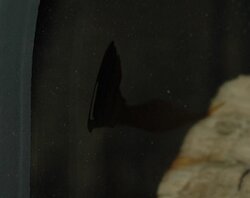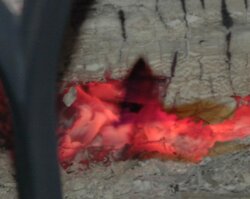Hi - It's been awhile since I last posted (sometime in last year's burning season). As I sit here by the side of the low fire I have burning in my Jotul Oslo, watching a tenuous gridiron struggle between Washington and Dallas, I figured I would come to the ever reliable font of woodburning information that is the Hearth.com forums. And so, I being my appeal for knowledge here.
In short, I noticed the other day that there was a strange brown, flamelike shape in my usually pristine stove glass. Figuring a log might have rolled against it, causing the usual buildup of creosote, I cleaned the door. No dice. Upon closer inspection, I realized that the strange, semi-transparent shape is inside the glass. Looking from the front or back you can see the parallax between it and the foreground/background.
During the day, my wife usually keeps the stove going so it's possible it might have happened then - I really don't know. Usual stove top temps are in the 400-500s depending on the wood, desired heat, etc. Has anyone seen this before? Is the glaze on the ceramic doing something strange?
Here's a couple pics if it helps.
In short, I noticed the other day that there was a strange brown, flamelike shape in my usually pristine stove glass. Figuring a log might have rolled against it, causing the usual buildup of creosote, I cleaned the door. No dice. Upon closer inspection, I realized that the strange, semi-transparent shape is inside the glass. Looking from the front or back you can see the parallax between it and the foreground/background.
During the day, my wife usually keeps the stove going so it's possible it might have happened then - I really don't know. Usual stove top temps are in the 400-500s depending on the wood, desired heat, etc. Has anyone seen this before? Is the glaze on the ceramic doing something strange?
Here's a couple pics if it helps.




